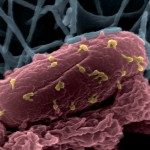Link to Pubmed [PMID] – 28329379
Clin. Infect. Dis. 2017 Jun;64(11):1582-1588
Background.: Other than numerous experimental data assessing phage therapy efficacy, questions regarding safety of this approach are not sufficiently addressed. In particular, as phages can kill bacterial cells within <10 minutes, the associated endotoxin release (ER) in severe infections caused by gram-negative bacteria could be a matter of concern.
Methods.: Two therapeutic virulent phages and 4 reference antibiotics were studied in vitro for their ability to kill 2 pathogenic strains of Escherichia coli and generate an ER. The early interaction (first 3 hours) between these actors was assessed over time by studying the instantaneous cell viability, the colony-forming unit count, the concentration of free endotoxin released, and the cell morphology under light microscope.
Results.: While β-lactams have a relatively slow effect, both tested phages, as well as amikacin, were able to rapidly abolish the bacterial growth. Even when considering the fastest phage (cell lysis in 9 minutes), the concentrations of phage-induced ER never reached the highest values, which were recorded with antibiotic treatments. Cumulative concentrations of endotoxin over time in phage-treated conditions were lower than those observed with β-lactams and close to those observed with amikacin. Whereas β-lactams were responsible for strong cell morphology changes (spheroplast with imipenem, filamentous cells with cefoxitin and ceftriaxone), amikacin and phages did not modify cell shape but produced intracellular inclusion bodies.
Conclusions.: This work provides important and comforting data regarding the safety of phage therapy. Therapeutically relevant phages, with their low endotoxin release profile and fast bactericidal effect, are not inferior to β-lactams.



